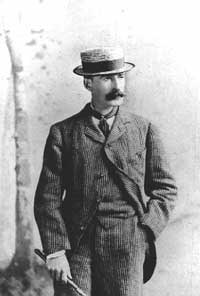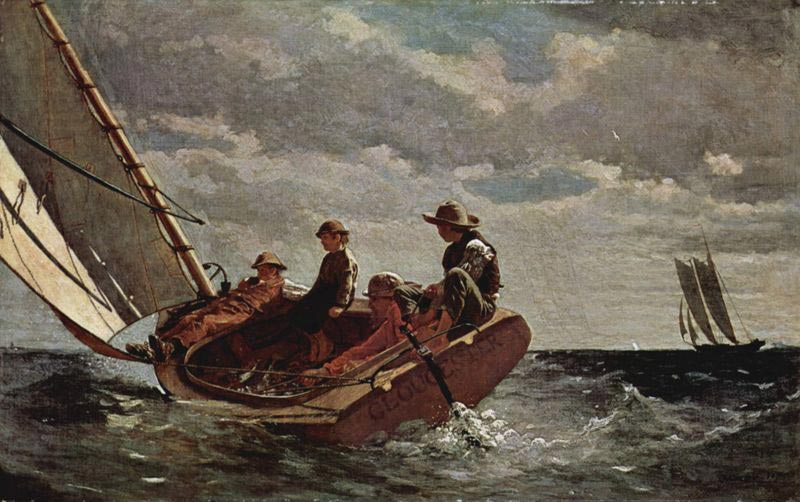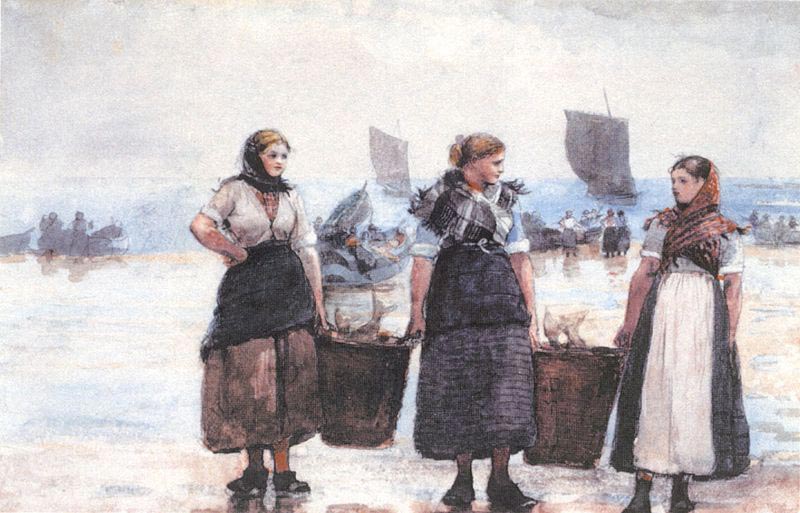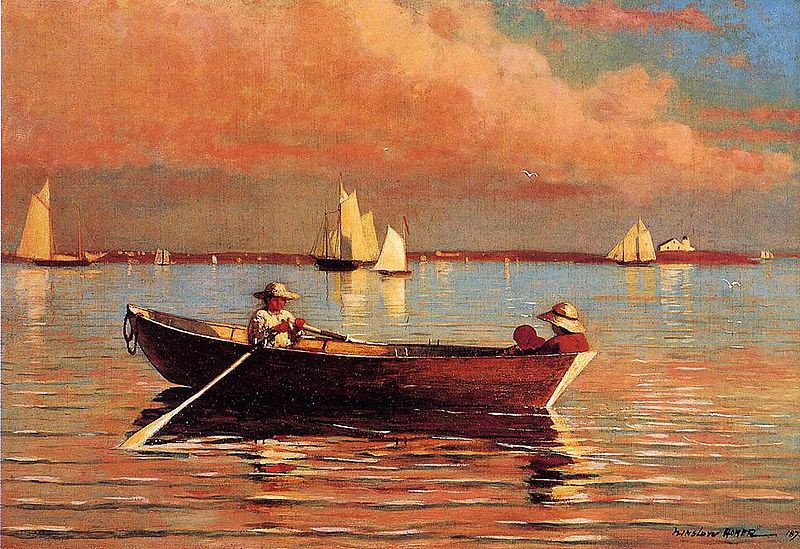| Winslow Homer | |
|---|---|
 |
|
| Born | Feb. 24, 1836 Boston, Massachusetts |
| Died | Sep. 29, 1910 (at age 74) Prouts Neck, Maine |
| Nationality | American |
| Education | Lithography apprenticeship, 1855-56 National Academy of Design (painting), 1863 Paris, France (informal), 1867 |
| Movement | Realism |
| Field | Drawing Wood engraving Oil painting Watercolor painting |
| Famous Paintings by Winslow Homer | |
| Snap the Whip | |
| The Gulf Stream | |
| Breezing Up (A Fair Wind) | |
| Right and Left | |
| The Fox Hunt | |
| Eight Bells | |
| The Life Line | |
| The Herring Net | |
| The Blue Boat | |
| Complete Works |
Winslow Homer was born on February 24, 1836 in Boston, Massachusetts. Homer, at age 19, became a trainee in a certain print-making corporation. In 1859, Homer transferred to New York and worked there as a freelance cartoonist. There and then, he developed some techniques in etching in simple forms with a dramatic contrast of shade and light.
Homer was self-educating himself even while he attended art classes. He experimented with the set of laws made by art theorists like Michel Chevreul. Michel’s “Laws on the Contrasts of Colour” was considered “Bible” by Homer.
Homer created a few seascapes made in oil like Beach Scene in 1869, which depicts girls and boys frolicking in the sea waves. Year 1873, Homer started to paint with watercolors, a medium that is considered amateurish and second-class. In his painting Three Boys on the Shore, Winslow contrasts the red patches in the sky and the foreground rocks with dark blue of the ocean broken by the drawn wonderful boys in their fodder hats and rutted clothing. The painting Moonlight in 1874 is an intimate and atmospheric rendition two lovers in which Winslow successfully triumphed over the hard task of painting two closely related colors brown and grey.
 In 1881, Winslow left for the British Empire and stayed for 20 long months in a fishing village north of Cullercoates. The village, along with its merrily dressed girls, had been popular with artists ever since 1820. However, when Homer arrived there, the surrounding country had intruded it and the economy was suffering under the Great Depression. Nonetheless, Homer still captured that changing world with a number of watercolor and charcoal drawings which caught the stoicism of girls and fisherwomen waiting for their men to come home from the hazards of the unsettled seas. Such study is represented in Fisher Girls in Shore, Tynemouth. The painting “Mending the Nets” is one of Homer’s best-known watercolors.
In 1881, Winslow left for the British Empire and stayed for 20 long months in a fishing village north of Cullercoates. The village, along with its merrily dressed girls, had been popular with artists ever since 1820. However, when Homer arrived there, the surrounding country had intruded it and the economy was suffering under the Great Depression. Nonetheless, Homer still captured that changing world with a number of watercolor and charcoal drawings which caught the stoicism of girls and fisherwomen waiting for their men to come home from the hazards of the unsettled seas. Such study is represented in Fisher Girls in Shore, Tynemouth. The painting “Mending the Nets” is one of Homer’s best-known watercolors.
With his artworks, he seemed to have conquered his lack of sketchiness and finish. He then went back to New York; but after two years, Homer left the urban and transferred to an isolated studio and windswept Prout’s Neck coastline of Maine, where he stayed until his death.
Here are some of Winslow Homer’s Works:
• The Life Line – Made on 1884, it depicts the remarkable transfer of a senseless woman from a destroyed ship to shore.
• The Lookout – Made on 1896, this painting is a night scene on a shipboard. It was painted in the moonlight and never was retouched by the daylight. In this painting, Winslow has caught the quintessence of poetry of the night at sea. The painting pictures starry skies, a ditch of white foam beneath; and then in between, there’s an ornamental bell of the ship, a deck’s corner, some ropes and a bearded face of an uplifted hand sailor. The sailor on the Lookout shouted “All is well”. The sailor’s mouth is open and gesturing accompanied what he shouted. The sailor is wearing an oilskin hat with his grizzled hair and all his sharp features.
• Kissing the Moon – Made in 1904, the medium used in this painting is oil in canvas. It depicts three men sailing in the moonlight.
• Boy Fishing – This was made in 1892. In this painting, watercolor is used. It shows a boy with hat fishing on the sea.
•  Key West – Made in 1903, watercolor and graphite was used on off-white wove paper. It had this simmering sunlight effects and a steamy atmosphere. It was achieved by the wet on wet washes application, dexterous and broad exploitation of white paper, and the sponging of wet coloring especially in the dimness, reverting light off the water. This is also exceptional because of the visibility and number of pencil marks.
Key West – Made in 1903, watercolor and graphite was used on off-white wove paper. It had this simmering sunlight effects and a steamy atmosphere. It was achieved by the wet on wet washes application, dexterous and broad exploitation of white paper, and the sponging of wet coloring especially in the dimness, reverting light off the water. This is also exceptional because of the visibility and number of pencil marks.
• Searchlight on Harbour Entrance of Santiago de Cuba- Painted in 1901, this painting shows a cannon in the forefront atop aged fortification and light beam coming from a spotlight. Homer depicts the obstruction of the Spanish navy in this painting.
• Home Sweet Home – Made in 1863, this painting shows two Union soldiers in a camp during the lull in battle. He made this base from his own experience in battle. The title of the painting refers to a song often played by the regimental band. The song inspired homesickness and longing of the men.
• The Sharpshooter on Picket Duty – Made in 1863, the painting shows a certain Union sharpshooter holding a telescopic rifle on a tree. It shows the intense look of the soldier concentrating on the battle. Homer became famous because of this painting.
• Weaning the Calf – Painted in 1875, thus shows three men weaning a calf.
• The Bridle Path – This was painted in 1868.
• A Rainy Day in Camp – This was painted in 1871.
• Gloucester Harbor – This was made in 1873.